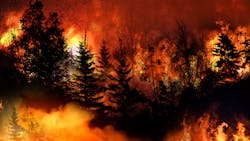To combat wildfires and keep the public safer, utilities will need arborists, software designers, vegetation management strategists, line workers, materials scientists, chemists, meteorologists and more. The skills and know-how from all kinds of disciplines and specialties will be needed to stave off this threat, both to reduce the chances of blazes sparking, as well as to protect service territories from fires already in progress.
Fire remedies can be high tech or low tech. We have advanced technologies like aerial imaging, satellites and LiDAR as well as traditional methods like right-of-way maintenance and vegetation management. However, as fire mitigation best practices evolve, the old ways complement the new ways. Something as old fashioned as tree trimming can now be “digitized” with augmented reality solutions that provide field crews with a complete history of an area’s vegetation management, sometimes right down to the specific tree in front of them. Detailed maps, climatological surveys, and near real-time data can be brought to bear on what used to be thought of as an uncomplicated task and can identify which trees might be hazardous to power grid equipment based on factors like soil conditions, rainfall, clearance and other data.
Right-of-way maintenance is another area where multiple scientific disciplines come together to help mitigate risks to people and property in novel ways. Instead of simply mowing and cutting back an ROW, utilities and contractors can now research plants and trees native to an area that are drought tolerant, grow slowly so as not to impact lines and provide wildfires with less fuel.
Utilities are already responding in new ways. Until recently, it would be unusual to come across a utility company with its own in-house climatology center to keep an eye on potential fire fuel and local moisture levels. It used to be unheard of for a utility company to maintain its own fleet of uncrewed aerial vehicles to check for potential power line impacts or material wear that could cause an arc flash. Companies offering free, open-source platforms that use artificial intelligence, machine learning and predictive models to gauge wildfire risk is not something you could expect years ago.
Materials scientists and chemists who work in the electric utility sector are always looking for better wood treatments, alloys or composites that can stand up to blazes. Engineers are building and testing out conductors that are shielded and include countermeasures against arc flashes that could, under the right conditions, shower dried vegetation with sparks and cause lethal and destructive fires. To stay informed of where disaster may be striking, line workers can install sensor systems networked by computer scientists that give grid operators a real-time view of exactly where and when a potential fault occurs so that field crews, when they are needed, know where to be as soon as the need to be there.
Botanists and chemists are studying more granular ground treatments that can be more safely and sustainably applied to keep plant life from negatively impacting the grid. Where public service power shutoffs must be used to prevent wildfires, researchers like those at the Electric Power Research Institute say distributed energy resources such as on-site battery storage, rooftop solar arrays or fuel cells could be used to support the power grid. Analysts, risk mitigation consultants and utility planners are also working to identify the areas of greatest risk for dangerous fires so that utilities can make the most out of their often limited resources and place assets where they can do the most good.
Smarter undergrounding techniques are also constantly under investigation by power engineers and utility planners so that the power grid and the public can reap the benefits of a more resilient, protected electrical delivery system. For overhead lines, power engineers have made great strides with the rapid earth fault current limiter (REFCL), which can cut the amount of energy transmitted through a power line down to a level that is not enough to spark a fire all within a fraction of a second of a line impact. This technology can often prevent a power service interruption as well as preventing a wildfire.
The risk of not preparing is a powerful motivator. We have seen the dire situations that arise when not enough is done to ready for disasters, and we know we have to do better. Power utilities are granted a tremendous amount of trust by critical service providers, regulators and the general public. It is a humbling task, but utilities have the good fortune of having some of the best minds in the world dedicated to the addressing this challenge.
About the Author
Jeff Postelwait
Managing Editor
Jeff Postelwait is a writer and editor with a background in newspapers and online editing who has been writing about the electric utility industry since 2008. Jeff is senior editor for T&D World magazine and sits on the advisory board of the T&D World Conference and Exhibition. Utility Products, Power Engineering, Powergrid International and Electric Light & Power are some of the other publications in which Jeff's work has been featured. Jeff received his degree in journalism news editing from Oklahoma State University and currently operates out of Oregon.
